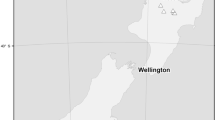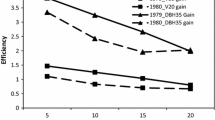Abstract
• Introduction
There is increasing interest in managing Eucalyptus nitens plantations for sawn timber production.
• Aims
This study aimed to determine the potential for genetic improvement of traits affecting green sawn board recovery in plantation-grown E. nitens.
• Methods
The study was undertaken on an E. nitens progeny trial. All trees were measured for diameter at breast height (DBH) and stem straightness, and 560 trees were selected for timber processing. Assessment was made of survival, log and green sawn board volume, log taper, and both upper and lower log end splitting. Genetic variation in and between these traits was estimated.
• Results
Genetic differences among races were significant for DBH at years 9 and 14, stem straightness, log taper and green sawn board volume. Within-race, narrow-sense heritabilities were significant for DBH, stem straightness, log volume, and both upper and lower log end splitting. Positive and significant additive genetic correlations were observed between DBH at all ages and survival, stem straightness and log volume. Significant adverse genetic correlations were shown between upper log end splitting and DBH at years 9 and 14.
• Conclusion
These findings showed that harvest-age stem straightness and log volume objective traits in E. nitens are amenable to genetic improvement and that selection for early-age DBH in breeding programmes should improve harvest-age survival, stem diameter and straightness, as well as log and green sawn board volume. However, these improvements are likely to be countered to some extent by increased end splitting of logs from larger trees.

Similar content being viewed by others
References
Arnold RJ, Johnson IG et al (2004) Genetic variation in growth, stem straightness and wood properties in Eucalyptus dunnii trial in Northern New South Wales. For Genet 11:1–12
AS 2082 (2000) Timber—hardwood—visually stress graded for structural purposes. Standards Australia, Homebush, NSW, p 51
Biechele T, Nutto L (2008) Growth stress in Eucalyptus nitens at different stages of development. Proccedings of the 51st International Convention of Society of Wood Science and Technology. November 10–12, Concepcion, Chile
Blackburn DP, Hamilton MG et al (2010) Stiffness and checking of Eucalyptus nitens sawn boards: genetic variation and potential for genetic improvement. Tree Genet Genomes 6:757–765
Blakemore P, Morrow A et al (2010) Plantation-grown Eucalyptus nitens: solid wood quality and processing performance on linear sawing systems with a range of commercial and experimental drying schedules. Technical Report 200. Cooperative Research Centre for Forestry, Hobart, Tasmania, Australia
Borralho NMG, Cotterill PP et al (1993) Breeding objectives for pulp production of Eucalyptus globulus under different industrial cost structures. Can J For Res 23:648–656
Bureau of Rural Sciences (2010) Australia's Plantations 2010 Inventory Update. Department Agriculture, Fisheries and Forestry–Bureau of Rural Sciences, Canberra, Australia
Callister AN, England N et al (2011) Genetic analysis of Eucalyptus globulus diameter, straightness, branch size, and forking in Western Australia. Can J For Res 41:1333–1343
Cannon T, Innes T (2008) Markets for the wood products from non-durable hardwood sawlog plantations. Proceedings from a Joint Venture Agroforestry Program Conference: Plantation Eucalypts for High-Value Timber: Enhancing Investment Through Research and Development. Rural Industries Research and Development Corporation, Moorabin, Victoria, Australia, pp 110–125
Chambers PGS, Borralho NMG et al (1996) Genetic analysis of survival in Eucalyptus globulus ssp. globulus. Silvae Genetica 45:107–112
Donnelly R, Fynn R et al (2003) The global eucalyptus wood products industry—a progress report on achieving higher value utilisation. DANA Publishing Limited, New Zealand
Eshbach OW (1975) Handbook of engineering fundamentals. Wiley, New York
Falconer DS, Mackay TFC (1997) Introduction to quantitative genetics. Addison Wesley Longman, Harlow, Essex
Gilmour AR, Cullis BR et al (2006) ASREML 2.0. VSN International Ltd., Hemel Hempstead, UK
Greaves BL, Raymond CA et al (1997) Breeding objective for plantation eucalypts grown for production of kraft pulp. For Sci 43:465–472
Griffin AR, Cotterill PP (1988) Genetic variation in growth of outcrossed, selfed and open-pollinated progenies of Eucalyptus regnans and some implications for breeding strategy. Silvae Genetica 37:124–131
Hamilton MG, Potts BM (2008) Review of Eucalyptus nitens genetic parameters. N Z J For Sci 38:102–119
Hamilton MG, Joyce K et al (2008) Achievements in forest tree improvement in Australia and New Zealand 9. Genetic improvement of Eucalyptus nitens in Australia. Aust For 71:82–93
Hamilton M, Potts B et al (2010) Genetic correlations between pulpwood and solid-wood selection and objective traits in Eucalyptus globulus. Ann For Sci 67:1–10
Kube PD, Raymond CA et al (2001) Breeding Eucalyptus nitens to improve wood quality and profitablility. In: Developing the eucalypt of the Future. INFOR, Valdivia, Chile, p 99
Larson PR (1963) Stem form development of forest trees. Forest Science Monographs 5:1–42
Macdonald E, Mochan S et al (2009) Validation of a stem straightness scoring system for Sitka spruce (Picea sitchensis (Bong.) Carr). Forestry 82:419–429
McKenzie HM, Turner JCP et al (2003) Processing young plantation-grown Eucalyptus nitens for solid-wood products. 1: Individual-tree variation in quality and recovery of appearance-grade lumber and veneer. N Z J For Sci 33:62–78
Mohammed CL, Battaglia M et al (2003) Mycosphaerella leaf diseases of temperate eucalypts around the Southern Pacific rim. N Z J For Sci 33:362–372
Nolan G, Greaves B et al (2005) Eucalypt plantations for solid wood products in Australia—a review. ‘If you don't prune it, we can't use it’. Forest & Wood Products Research & Development Corporation, Victoria, Australia
Parsons M, Gavran M et al (2006) Australia's Plantations 2006. Bureau of Rural Sciences Co.
Ponzoni RW, Newman S (1989) Developing breeding objectives for Australian beef cattle production. Anim Prod 49:35–47
Purnell RC (1988) Variation in wood properties of Eucalyptus nitens in a provenance trial on the Eastern Transvaal Highveld in South Africa. South African For J 144:10–22
Raymond C (2002) Genetics of Eucalyptus wood properties. Ann For Sci 59:525–531
Self SG, Liang KY (1987) Asymptotic properties of maximum likelihood estimators and likelihood ratio tests under nonstandard conditions. J Am Stat Soc 82:605–610
Stackpole DJ, Vaillancourt RE et al (2010) Age trends in genetic parameters for growth and wood density in Eucalyptus globulus. Tree Genet Genomes 6:179–193
Telles dos Santos EPT, Geraldi IO et al (2004) Estimates of genetic parameters of wood traits for sawn timber production in Eucalyptus grandis. Genet Mol Biol 27:567–573
Tibbits WN, Hodge GR (2003) Genetic parameters for cold hardiness in Eucalyptus nitens (Deane & Maiden) Maiden. Silvae Genetica 52:89–97
Valencia J, Harwood C, Washusen R et al (2011) Longitudinal growth strain as a log and wood quality predictor for plantation-grown Eucalyptus nitens sawlogs. Wood Sci Technol 45:15–34
Washusen R, Innes T (2008) Processing plantation eucalypts for high-value timber. Proceedings from a Joint Venture Agroforestry Program Conference: Plantation Eucalypts for High-Value Timber: Enhancing Investment Through Research and Development. Rural Industries Research and Development Corporation, Moorabin, Victoria, Australia, pp 92–109
Washusen R, Morrow A, Valencia JC et al (2007) Gould's Country Eucalyptus nitens thinning trial: solid wood quality and processing performance using conventional processing strategies. Technical Report 168. Cooperative Research Centre for Forestry, Hobart
Washusen R, Harwood CE et al (2009) Pruned plantation-grown Eucalyptus nitens: effects of thinning and conventional processing strategies on sawn board quality and recovery. N Z J For Sci 39:39–55
White TL, Adams WT, Neale D (2007) Forest genetics. CABI, Wallingford
Yang JL (2005) The impact of log-end splits and spring on sawn recovery of 32-year-old plantation Eucalyptus globulus Labill. Holz als Roh-und Werkstoff 63:442–448
Yang JL, Pongracic S (2004) The impact of growth stress on sawn distortion and log end splitting on 32-year-old plantation blue gum. Project no: PN03.1312 Forest and Wood Products Research Development Corporation, Melbourne, Australia, p 31
Yang JL, Fife D et al (2001) The effect of growth strain and other defects on the sawn timber quality of 10-year-old Eucalyptus globulus Labill. Aust For 65:31–37
Acknowledgements
The study was supported by the Cooperative Research Centre for Forestry. We acknowledge the work of Dr Peter Volker in planning and establishing the progeny trial, which is part of a series of trials which underpins Forestry Tasmania’s E. nitens tree breeding programme. We thank Dr. Greg Dutkowski for helpful advice on quantitative genetic analysis.
Funding
We acknowledge substantial assistance from Forestry Tasmania, which provided trees from their progeny trial and personnel for straightness assessment, Forest Enterprises Australia Ltd. for processing the logs, and the Cooperative Research Centre for Forestry for David Paul Blackburn’s PhD scholarship funding.
Author information
Authors and Affiliations
Corresponding author
Additional information
Handling Editor: Barry Alan Gardiner
Rights and permissions
About this article
Cite this article
Blackburn, D.P., Hamilton, M.G., Harwood, C.E. et al. Genetic variation in traits affecting sawn timber recovery in plantation-grown Eucalyptus nitens . Annals of Forest Science 68, 1187–1195 (2011). https://doi.org/10.1007/s13595-011-0130-y
Received:
Accepted:
Published:
Issue Date:
DOI: https://doi.org/10.1007/s13595-011-0130-y




